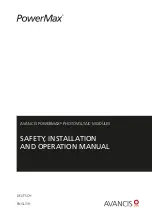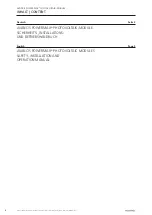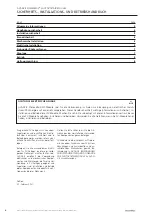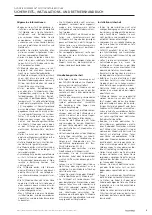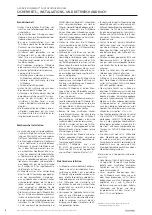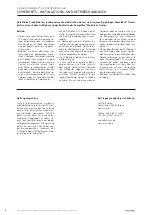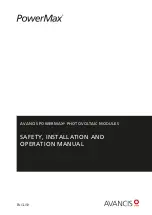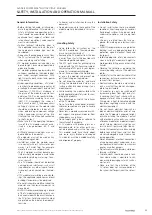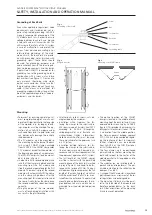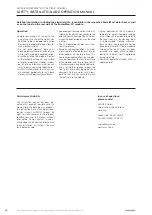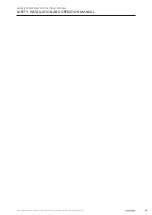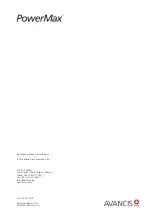
SAFETY, INSTALLATION AND OPERATION MANUAL
AVANCIS POWERMAX
®
PHOTOVOLTAIC MODULES
11
©2021 | AVANCIS GmbH | Solarstraße 3 | 04860 Torgau | Germany | [email protected] | www.avancis.de | February 2021
General Information
• Before starting to handle, install and op-
erate the photovoltaic (PV) modules, all
safety, installation and operation instruc-
tions should be understood. Follow all
applicable local, regional, national and
international regulations, code require-
ments and standards.
• Further technical information given in
the applicable technical data sheet of
the appropriate module type must be
considered.
• Keep unauthorized people away from
the PV system and the PV components
when unpacking and installing.
• PV modules produce voltage when ex-
posed to light, even when operated in
open circuit mode.
• PV modules produce approximately full
voltage as specified on the module label,
even under lowlight conditions. With
light intensity, both current and power
will increase.
• Under operating conditions, a PV mod-
ule is likely to produce more current and/
or voltage than reported at Standard Test
Conditions (1,000 W/m² irradiance in
the plane of the module, module tem-
perature of 25 °C and a spectral distribu-
tion of irradiance according to air mass
[AM] 1.5). Accordingly, the values of
short circuit current (I
sc
) and open circuit
voltage (V
oc
) given on the module label
should be multiplied by a factor of 1.25
when determining component voltage
ratings, conductor current rating, fuse
sizes and the size of controls connected
to the PV output.
• Make sure that the operating tempera-
ture of the PV modules remains exclu-
sively in a range between -40 °C and
+85 °C.
• Artificially concentrated light must not
be directed on the modules.
• The modules must not be used on any
kind of moving vehicles.
• Installations where the modules come
into contact with salt, salt water or per-
manent salt water fog, for example,
close to the sea, are not permitted.
• The PV modules must not become par-
tially or wholly submerged in water or be
exposed to splashing water (e.g., foun-
tains, sea surf).
• The PV modules should not be located
near aggressive substances, such as salt
(see above) or any other types of corro-
sive agent, which could harm the mod-
ule.
• If PV modules are installed in or on build-
ings, the applicable regulations and local
building standards must be observed.
• Do not disassemble, modify or adapt the
modules and their serial numbers or re-
move labels.
• AVANCIS recommends keeping a record
of the PV module serial and variant num-
bers associated with the exact location in
the PV system. Serial and variant number
are printed on the label on the module‘s
rear side.
• Customer and installer should save this
document.
• Apply pressure only to those parts of the
module explicitly described in this man-
ual.
Handling Safety
• Please follow the instructions on the
AVANCIS module box. The module box-
es are not weather-resistant.
• Removing the PV modules from the box
is easier if you start at the box side with
the module positioned higher.
• The EPS parts used for packaging are
marked with the EPS-Recycling symbol.
For recycling of EPS parts in your region,
please visit www.epsrecycling.org.
• Do not stand or step on the module box-
es or on the modules and prevent ob-
jects from falling on the modules.
• Do not drop the modules, and avoid
setting the module down hard on any
surface, particularly when placing it on a
module corner.
• While handling the modules, follow the
locally applicable job safety rules for han-
dling glass products.
• Do not damage or scratch the surfaces
of the PV modules.
• Do not use the junction boxes, electrical
cables or connectors as a grip to handle
the PV modules.
• Never lean a module unsecured or with-
out support, and prevent modules from
sliding down any surfaces.
• Do not apply paint, glue or adhesive to
the surface of the module.
• A PV module with broken glass or a
damaged back rail or other parts can-
not be repaired and must not be used.
This module could have sharp edges
and cause injury. Broken or damaged
PV modules must be handled carefully
and disposed of properly.
Installation Safety
• Do not install when there are adverse
conditions, like strong or gusty winds or
frosted roof surfaces. Also do not work
under wet conditions, and use dry tools
only.
• Use only insulated tools that are ap-
proved for working on electrical instal-
lations.
• AVANCIS recommends to use protective
clothing, such as appropriate gloves for
protection against electrical shock and
sharp parts.
• Follow appropriate safety requirements
when installing PV modules at heights to
avoid possible falling or any other safety
hazards.
• Observe the restrictions regarding the
minimal bending radius of the electrical
cables.
• Securely fasten the electrical cables after
connection, but avoid any excessive me-
chanical stress on them.
• Electrical cables should be mounted in
such a way that they do not cause peo-
ple to trip or stumble.
• PV modules can only be switched off
by removing them from light or by ful-
ly covering their front surface with an
opaque material. When working with
PV modules in light, follow all applicable
regulations regarding working with live
electrical equipment.
• Do not touch electrical terminals or
broken electrical cables or ends of wire
while the PV module is exposed to light
or while installing the module. Contact
with electrically active parts, any surface
of broken modules or modules suspect-
ed of lacking electrical insulation can
result in burns, sparks and lethal shock.
• Ensure that connectors are clean and dry
before connecting them and that they
are not submerged in water, snow or ice
during operation.
• Never disconnect electrical connections
or unplug connectors under load, in or-
der to prevent direct current to arc across
gaps or any other dangers.
• Do not wear metallic jewelery while per-
forming installation.
• Cable conduits should be used in loca-
tions where wiring is accessible to chil-
dren or cable-damaging animals, such as
marten, etc.
• Make sure that the installation of the
PV system does not cause corrosion of
the system itself or parts near the system.
Содержание POWERMAX
Страница 1: ...AVANCIS POWERMAX PHOTOVOLTAIC MODULES SAFETY INSTALLATION AND OPERATION MANUAL DEUTSCH ENGLISH ...
Страница 3: ...AVANCIS POWERMAX PHOTOVOLTAIK MODULE SICHERHEITS INSTALLATIONS UND BETRIEBSHANDBUCH DEUTSCH ...
Страница 9: ...ENGLISH AVANCIS POWERMAX PHOTOVOLTAIC MODULES SAFETY INSTALLATION AND OPERATION MANUAL ...

